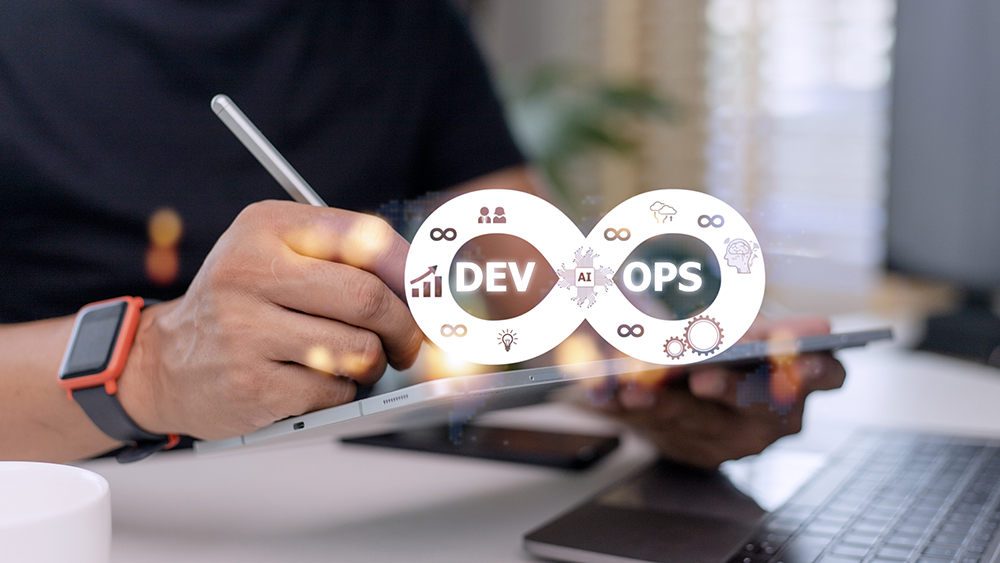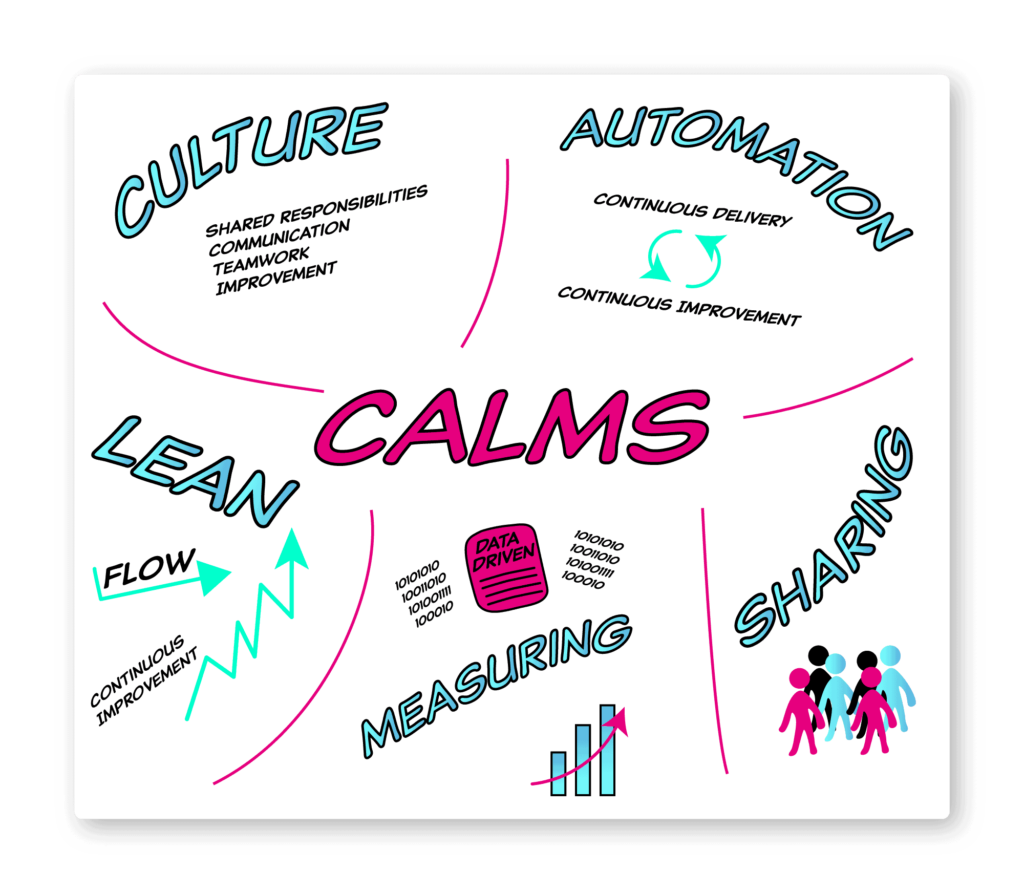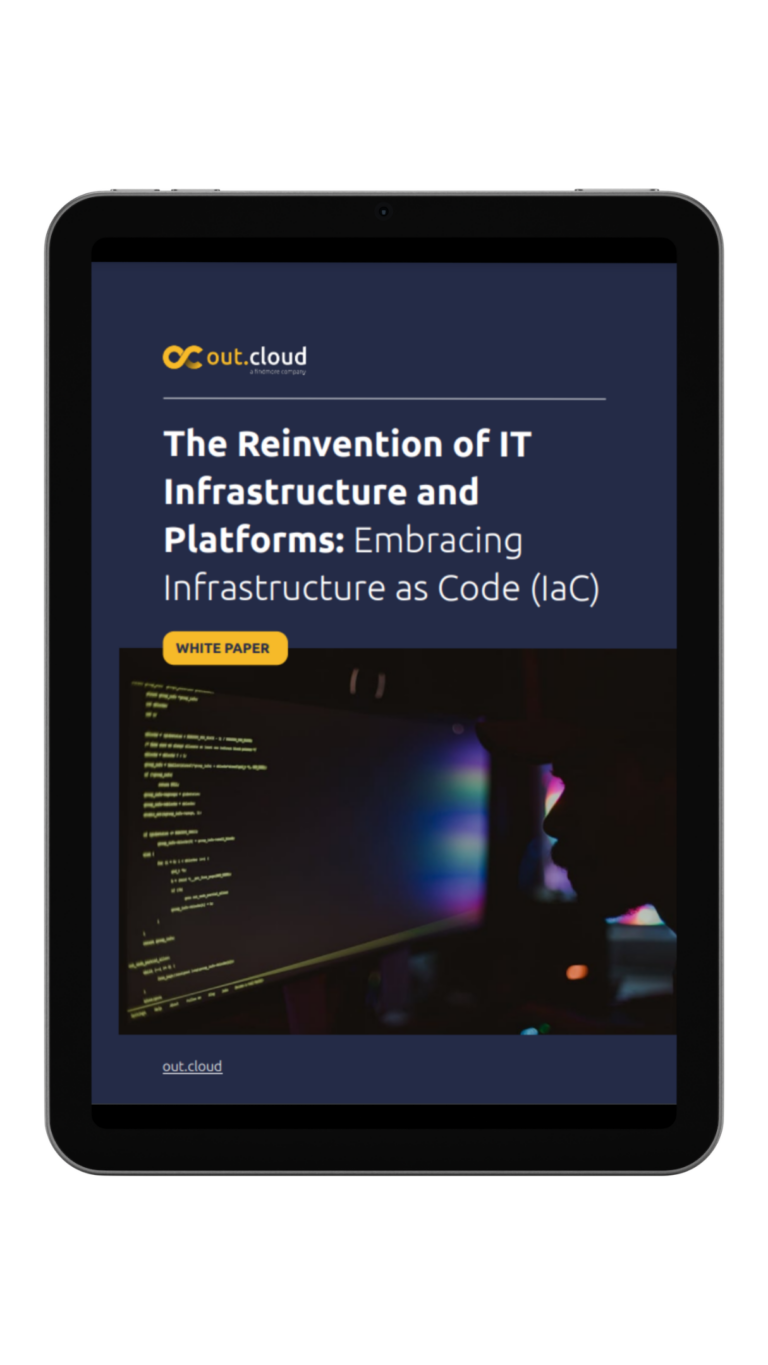Section 1: Understanding DevOps Transformation

What is DevOps implementation?
DevOps implementation refers to the adoption and integration of DevOps practices and principles within an organization. It involves aligning development, operations, and other relevant teams to establish a collaborative and iterative approach to software delivery. DevOps implementation aims to enhance agility, efficiency, and quality throughout the software development lifecycle, from planning and development to testing, deployment, and monitoring.
What is a DevOps transformation?
A DevOps transformation is a comprehensive journey undertaken by organizations to embrace the DevOps philosophy and practices. It involves a cultural shift, process improvements, and the adoption of appropriate tools and technologies. A successful DevOps transformation transcends individual teams and departments, focusing on breaking down silos and fostering collaboration to enable faster, more reliable software delivery and enhanced customer satisfaction.
Section 2: The Three Elements of DevOps
What are the 3 elements of DevOps?
DevOps is built upon three essential elements: people, processes, and technology. These elements work together synergistically to create an environment conducive to successful DevOps implementation.

1. People
The people element of DevOps emphasizes the importance of collaboration, communication, and shared responsibility. It involves breaking down the barriers between development, operations, and other teams, fostering a culture of trust, and encouraging cross-functional collaboration. By aligning teams and providing opportunities for skill development and knowledge-sharing, organizations can empower their people to drive the DevOps transformation.
2. Processes
Processes play a crucial role in DevOps implementation by streamlining workflows, ensuring efficiency, and promoting consistent, repeatable practices. DevOps encourages the adoption of agile methodologies, such as continuous integration, continuous delivery, and continuous deployment (CI/CD). These processes enable faster feedback loops, automate repetitive tasks, and facilitate the seamless integration of code changes into production environments.
3. Technology
Technology serves as an enabler of DevOps practices, supporting the collaboration, automation, and measurement required for successful implementation. DevOps emphasizes the use of infrastructure as code (IaC), which allows organizations to define and manage infrastructure resources programmatically. Additionally, DevOps leverages a range of tools and technologies for source code management, automated testing, deployment orchestration, monitoring, and more.
Section 3: Key Components of DevOps Implementation
What are the key components of DevOps implementation?
DevOps implementation encompasses several key components that are crucial for successful adoption and integration. These components work together to create a foundation for efficient and collaborative software delivery.

1. Culture
Culture is a fundamental component of DevOps implementation. It involves fostering a mindset of collaboration, shared responsibility, and continuous improvement. A DevOps culture encourages open communication, trust, and a focus on learning from both successes and failures. By promoting a positive and collaborative work environment, organizations can break down silos and facilitate effective cross-team collaboration.
2. Automation
Automation plays a vital role in DevOps implementation by reducing manual effort, minimizing errors, and accelerating software delivery. It involves automating various aspects of the software development lifecycle, such as building, testing, deployment, and monitoring. By automating repetitive tasks, organizations can streamline processes, improve efficiency, and achieve consistent and reliable results.
3. Measurement
Measurement is essential in DevOps to gain insights, track progress, and drive continuous improvement. It involves establishing metrics and key performance indicators (KPIs) to monitor the performance, quality, and efficiency of software delivery processes. By collecting and analyzing data, organizations can identify bottlenecks, optimize workflows, and make data-driven decisions to enhance their DevOps practices.
4. Sharing
Sharing knowledge, information, and feedback is a critical component of DevOps implementation. It involves fostering a culture of transparency, collaboration, and continuous learning. Through effective communication and knowledge-sharing practices, teams can leverage each other’s expertise, learn from past experiences, and collectively contribute to the improvement of processes and outcomes.
Section 4: Implementing DevOps Step by Step

How do you implement DevOps step by step?
Implementing DevOps requires a systematic approach that involves several key steps. By following these steps, organizations can lay the groundwork for a successful DevOps implementation and foster a culture of collaboration and continuous improvement.
1. Assess the Current State
The first step in implementing DevOps is to assess the current state of your organization‘s development and operations processes. Identify pain points, bottlenecks, and areas for improvement. This assessment will provide valuable insights into the specific challenges and opportunities that need to be addressed during the DevOps transformation.
2. Define Goals and Objectives
Clearly define the goals and objectives you want to achieve through DevOps implementation. These goals could include faster time-to-market, improved quality, increased efficiency, and enhanced customer satisfaction. By establishing clear objectives, you can align your efforts and measure progress throughout the implementation process.
3. Establish Cross-functional Teams
Form cross-functional teams that bring together members from different departments, including development, operations, quality assurance, and other relevant areas. These teams should have end-to-end responsibility for delivering software and be empowered to make decisions and drive continuous improvement. Encourage collaboration, shared responsibility, and effective communication within and across these teams.
4. Implement Automation
Automation is a core principle of DevOps. Identify areas of your software development lifecycle that can benefit from automation, such as build and deployment processes, testing, and infrastructure provisioning. Adopt tools and technologies that enable automation and streamline these processes. Automation helps reduce manual errors, speed up delivery, and improve overall efficiency.
5. Foster Continuous Improvement
DevOps is an iterative process, and continuous improvement is key to its success. Encourage a culture of learning and experimentation, where teams can identify areas for improvement, test new ideas, and iterate on processes. Regularly evaluate and refine your DevOps practices to align with changing business needs and technological advancements.
Section 5: Leading a Successful DevOps Transformation
How do you lead a DevOps transformation?
Leading a DevOps transformation requires strong leadership, effective communication, and a clear vision. Here are some key steps to lead a successful DevOps transformation:
1. Create a Compelling Vision
Establish a clear and compelling vision for the DevOps transformation. Communicate the benefits and value of DevOps to all stakeholders, including executives, managers, and team members. Emphasize the positive impact it will have on customer satisfaction, business agility, and overall success.
2. Build a Cross-functional Transformation Team
Form a dedicated cross-functional team responsible for leading the DevOps transformation. This team should consist of individuals with diverse expertise from different areas of the organization, including development, operations, and leadership. Assign clear roles and responsibilities to team members, empowering them to drive the transformation forward.
3. Foster a Culture of Collaboration and Continuous Learning
Promote a culture of collaboration, trust, and continuous learning throughout the organization. Encourage open communication, knowledge sharing, and cross-team collaboration. Provide opportunities for skill development, training, and learning from industry best practices. Foster an environment where experimentation and learning from failures are valued.
4. Lead by Example
As a leader, it’s essential to lead by example and embody the principles of DevOps. Embrace transparency, open communication, and a growth mindset. Encourage team members to take ownership, make data-driven decisions, and continuously improve their processes. Demonstrate a commitment to collaboration, inclusivity, and continuous learning.
5. Provide the Necessary Resources and Support
Ensure that teams have the necessary resources, tools, and support to adopt DevOps practices. Invest in modern infrastructure, automation tools, and technologies that enable seamless collaboration and efficient software delivery. Support teams in their learning and skills development journey by providing training opportunities and access to relevant resources.
6. Monitor Progress and Celebrate Success
Regularly monitor the progress of the DevOps transformation and celebrate milestones and successes along the way. Use key performance indicators (KPIs) and metrics to track the impact of DevOps on delivery speed, quality, customer satisfaction, and business outcomes. Recognize and reward individuals and teams for their contributions to the transformation.
Section 6: The Five Pillars of DevOps
What are the 5 pillars of DevOps?
DevOps is built upon five key pillars that serve as guiding principles for successful implementation. These pillars encompass various aspects of DevOps practices and contribute to its overall effectiveness. The five pillars of DevOps are:
1. Culture Mindset
Culture is a foundational pillar of DevOps. It emphasizes creating a culture of collaboration, trust, and continuous learning. A strong DevOps culture encourages shared responsibility, effective communication, and the breaking down of silos between teams. It fosters a growth mindset and embraces experimentation, feedback, and continuous improvement.
2. Automation
Automation is a core pillar of DevOps, enabling organizations to streamline and accelerate their software delivery processes. By automating tasks such as building, testing, and deployment, teams can achieve faster, more reliable delivery with reduced manual effort and minimized errors. Automation also allows for greater scalability and repeatability in the software development lifecycle.
3. Measurement
Measurement plays a crucial role in DevOps, providing insights into the performance and effectiveness of software delivery processes. By establishing metrics and key performance indicators (KPIs), organizations can track the success of their DevOps initiatives, identify areas for improvement, and make data-driven decisions. Measurement helps drive continuous improvement and enables teams to iterate and optimize their processes.
4. Sharing
Sharing knowledge, information, and feedback is a vital pillar of DevOps. It promotes transparency, collaboration, and cross-functional learning. Through effective communication and sharing of ideas, teams can leverage each other’s expertise, learn from past experiences, and collectively contribute to the improvement of processes and outcomes. Sharing fosters a culture of trust, innovation, and continuous learning.
5. Outcomes
The outcomes pillar of DevOps focuses on delivering value to customers and achieving business goals. DevOps aims to enhance customer satisfaction, speed to market, and overall business performance. By aligning development and operations teams towards common objectives and outcomes, organizations can drive innovation, increase competitiveness, and create a positive impact on the bottom line.
Section 7: The First Step of the DevOps Transformation
What is the first step of the DevOps transformation?
Embarking on a DevOps transformation requires a thoughtful and strategic approach. While there are various ways to initiate the journey, one crucial first step is to establish a sense of urgency and create awareness about the need for change.
Assess the Current State
The initial step in the DevOps transformation is to assess the current state of your organization’s development and operations practices. Evaluate the existing workflows, processes, and collaboration between teams. Identify pain points, inefficiencies, and areas where improvement is needed. This assessment provides a baseline understanding of the challenges and opportunities for transformation.
Define the Vision
Once the current state is assessed, it is essential to define a compelling vision for the DevOps transformation. The vision should articulate the desired future state, highlighting the benefits, outcomes, and value the transformation will bring to the organization, its customers, and its employees. This vision serves as a guiding light and aligns everyone towards a common goal.
Secure Leadership Buy-in
Obtaining leadership buy-in and support is crucial for a successful DevOps transformation. Engage executive stakeholders, articulate the business case for DevOps, and demonstrate how it aligns with organizational goals and objectives. Secure their commitment to provide the necessary resources, budget, and support to drive the transformation forward.
Start with a Pilot Project
To gain momentum and build confidence, it’s recommended to start the DevOps transformation with a pilot project. Choose a project that has clear goals, manageable scope, and cross-functional collaboration opportunities. This pilot project allows teams to apply DevOps principles and practices in a controlled environment, learn from the experience, and demonstrate the value of DevOps to the broader organization.
Establish a Roadmap
Develop a roadmap that outlines the steps, milestones, and timelines for the DevOps transformation. Identify the key initiatives, processes, and technologies that need to be addressed. Break down the transformation journey into manageable phases, focusing on quick wins and incremental improvements. A well-defined roadmap helps keep the transformation on track and provides a clear path forward.
Section 8: Overcoming DevOps Transformation Challenges
What are the common challenges in DevOps transformation?
While DevOps transformation brings numerous benefits, it is not without its challenges. Recognizing and addressing these challenges is essential for a successful transformation. Here are some common challenges organizations may encounter during the DevOps transformation journey:
1. Cultural Resistance
Cultural resistance is a significant challenge in DevOps transformation. Shifting to a collaborative and cross-functional culture requires breaking down silos, overcoming resistance to change, and fostering a mindset of shared responsibility. It may take time and effort to gain buy-in from individuals and teams, but by fostering open communication, providing training, and leading by example, cultural transformation can be achieved.
2. Legacy Systems and Processes
Legacy systems and processes can pose challenges in adopting DevOps practices. Outdated technologies, complex architectures, and manual processes may hinder automation and efficient collaboration. Organizations must assess and modernize their systems and processes, gradually replacing legacy components and adopting DevOps-friendly technologies.
3. Skill Gaps
Skill gaps can hinder the DevOps transformation. Effective collaboration and automation require a certain level of technical expertise and familiarity with DevOps tools and practices. Organizations should invest in training and upskilling programs to ensure teams have the necessary skills to embrace DevOps principles and utilize the relevant tools effectively.
4. Toolchain Integration
Integrating the various tools and technologies across the DevOps toolchain can be complex. Organizations often use a combination of tools for version control, continuous integration, deployment orchestration, monitoring, and more. Ensuring seamless integration and interoperability between these tools is vital for efficient collaboration and automation.
5. Continuous Improvement
Continuous improvement is a key principle of DevOps, but it can be challenging to sustain. Organizations must establish mechanisms for capturing feedback, evaluating metrics, and identifying areas for improvement. Creating a culture that values experimentation, learning from failures, and implementing iterative changes is crucial for ongoing success.
Section 9: DevOps Practices Being Effectively Leveraged
How are DevOps practices being effectively leveraged?
DevOps practices have evolved and matured over time, enabling organizations to achieve significant improvements in software delivery, collaboration, and overall business outcomes. Here are some key DevOps practices that are being effectively leveraged by organizations:
1. Continuous Integration and Continuous Delivery (CI/CD)
Continuous Integration (CI) and Continuous Delivery (CD) are foundational practices in DevOps. CI involves automatically integrating code changes from multiple developers into a shared repository, followed by automated build and testing processes. CD focuses on automating the deployment of code changes to various environments, ensuring a smooth and reliable release process.
2. Infrastructure as Code (IaC)
Infrastructure as Code (IaC) is a practice that enables the provisioning and management of infrastructure resources through code definitions. By treating infrastructure as code, organizations can version control their infrastructure configurations, apply consistent and repeatable provisioning, and automate the infrastructure setup and teardown processes.
3. Automated Testing
Automated testing is crucial for ensuring the quality and reliability of software releases. DevOps encourages organizations to adopt a comprehensive suite of automated tests, including unit tests, integration tests, and end-to-end tests. Automated testing helps catch issues early in the development cycle, reduces manual effort, and allows for faster feedback on code changes.
4. Monitoring and Observability
Monitoring and observability practices enable organizations to gain insights into the performance and health of their systems. By implementing robust monitoring solutions and utilizing logging, metrics, and tracing tools, teams can proactively identify and address issues, optimize system performance, and ensure a positive end-user experience.
In fact, according to The 2022 Accelerate State of DevOps Report by DORA (DevOps Research and Assessment), organizations that prioritize monitoring and observability in their DevOps practices have shown higher levels of software delivery performance and operational efficiency.
5. Collaboration and Communication Tools
Effective collaboration and communication are critical for successful DevOps implementation. Organizations leverage a variety of tools, such as chat platforms, project management tools, and collaboration suites, to facilitate communication, knowledge sharing, and cross-team collaboration. These tools promote transparency, streamline communication, and enable remote collaboration.
Section 10: The Future of DevOps
DevOps continues to evolve and adapt as technology advancements and market demands shape the future of software delivery and IT operations. Here are some key trends and predictions for the future of DevOps:
1. Cloud-native DevOps
The adoption of cloud computing has significantly influenced DevOps practices, and this trend is expected to continue. Cloud-native DevOps emphasizes leveraging cloud platforms, microservices architectures, and containerization technologies for increased scalability, flexibility, and portability. Organizations will further embrace cloud-native principles and tools to drive innovation and accelerate software delivery.
2. DevSecOps
Security integration within DevOps, known as DevSecOps, is gaining prominence as organizations recognize the importance of building security into their software delivery lifecycle from the beginning. DevSecOps focuses on embedding security practices, such as vulnerability scanning, security testing, and compliance checks, throughout the development and deployment processes.
3. Artificial Intelligence and Machine Learning
Artificial Intelligence (AI) and Machine Learning (ML) technologies are expected to play a significant role in the future of DevOps. These technologies can automate tasks, analyze vast amounts of data for insights, and optimize various aspects of software delivery, such as testing, monitoring, and incident response. AI-driven analytics and intelligent automation will enhance DevOps practices and decision-making.
4. Value Stream Management
Value Stream Management (VSM) focuses on end-to-end visibility and optimization of the software delivery value stream. It involves analyzing and improving the flow of work, identifying bottlenecks, and optimizing resource utilization. VSM enables organizations to gain insights into the entire software delivery process, align efforts with business goals, and drive continuous improvement.
5. DevOps for Non-IT Domains
While DevOps has primarily been associated with IT and software development, its principles and practices are starting to expand into non-IT domains. Industries such as finance, healthcare, and manufacturing are adopting DevOps concepts to improve operational efficiency, collaboration, and product delivery. DevOps principles can be applied to various domains to drive innovation and agility.
Conclusion
In conclusion, DevOps has emerged as a transformative approach that bridges the gap between development and operations, enabling organizations to deliver software faster, more reliably, and with greater quality. It encompasses a cultural shift, automation, measurement, sharing, and a focus on achieving valuable outcomes.
By implementing DevOps practices, organizations can experience a multitude of benefits, including faster deployment, improved customer experience, cost reduction, efficient problem-solving, and continuous improvement. However, the journey of DevOps transformation comes with its challenges, such as cultural resistance, legacy systems, skill gaps, and toolchain integration. Addressing these challenges requires strong leadership, effective communication, and a commitment to continuous learning.
As the DevOps landscape evolves, cloud-native DevOps, DevSecOps, AI/ML integration, value stream management, and the expansion of DevOps into non-IT domains are shaping the future of this discipline. Organizations that embrace these trends and continue to refine their DevOps practices will be well-positioned to drive innovation, enhance competitiveness, and deliver value to their customers.
In your own journey of DevOps implementation and transformation, remember to assess your current state, define clear goals, foster a collaborative culture, leverage automation and measurement, and continuously seek opportunities for improvement. With dedication, perseverance, and a focus on the principles of DevOps, you can unlock the full potential of this transformative approach and achieve remarkable results.
Thank you for joining us on this comprehensive guide to DevOps transformation. If you have any further questions or would like assistance in your DevOps journey, feel free to reach out to us.






